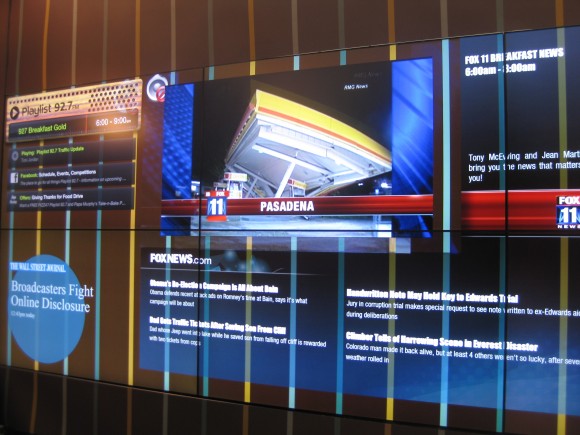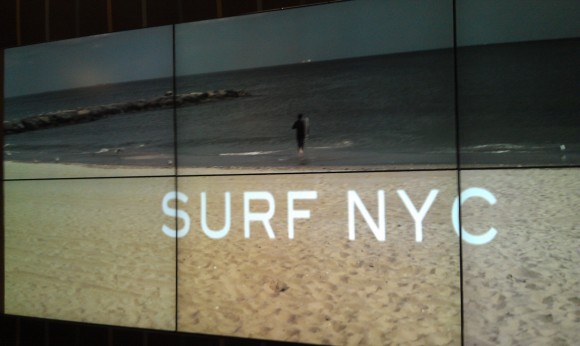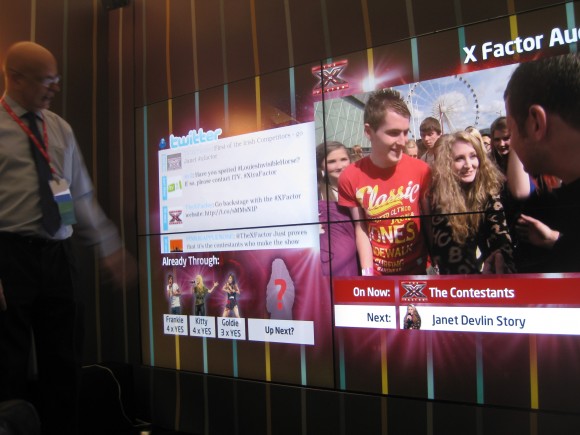
By far my favorite thing at the Cable Show this year has been the NDS concept demo of Surfaces, a next-gen TV experience that puts video on the walls around you. The theory from NDS – a set-top and video software company out of the UK – is that TV doesn’t have to fit into a TV set. Instead, it can be overlaid on modular panels that give you the flexibility to see video in different sizes and combine it with other information and associated content.
In the demo I saw yesterday, NDS showed everything from TV clips to music playlists, news feeds and a baby monitor “live” stream. The demo was controlled from an iPad, but all of the content appeared on the wall in front of us in a variety of layouts. For example, one moment we were watching a movie across an entire wall of seamlessly connected screens, but the next we were interacting with a mosaic of widgets that pushed TV content to a much smaller window off to the side of the viewing area.
NDS also showed off 4K-resolution video on the wall-sized display. (Sourced from YouTube, by the way…) Words don’t do it justice, and unfortunately neither does the photo I took with my cheap point-and-shoot camera. However, suffice it to say, the effect is stunning.

Most of the features in the demo were applications you might expect to see executed on an iPad, but there is a difference when that content and interactivity is writ large for an entire room. It’s also fascinating to be able to move instantly from an immersive video experience – where it literally feels like you’re in a movie theater – to a more social and/or productive one with information pouring in from all sides.

Unfortunately, the NDS demo is just that, a demo. There’s nothing you can buy today, or likely any time in the next five years, unless you want to import your own home theater experts and spends tens of thousands of dollars. However, we all need a glimpse of the future now and then, not to mention a break from trade talk of set-tops and HFC networks. And now that Cisco has acquired NDS, who knows? Maybe we’ll get a real product somewhere down the line. We can certainly dream.
What are you going still shooting pics with a digital camera? Use your phone and have the photostream sync to your laptop. (A guy at work mentioned Dropbox does this for Android.) I haven’t shot a blog picture with anything other than an iPhone in like 18 months. Work smarter, not harder. ;)
Very cool, this is straight out of Total Recall (the original, Arnold one).
Since Google is already working on Johnny Cabs, should I wonder if memory implantation is too far off?
This is really cool tech that was announced a little while ago (forget which show… CTIA?). Like Tom, it also reminds me of Total Recall but other movies use stuff like that. It’s kind of amazing that we’ve come so far and it can all be accomplished with current-gen tech (not cheap but 4K projectors are on the market; Sony’s is supposedly excellent & does great upscaling from 1080p and RED will release one for about $10K soon).
this one is more like the movie Minority Report. Immersive isgreat when you control the content – but these types of things will start showing up in upscale offices and the content will be by the company that owns the space.
Still – having a wall in your come alive with HD or better on a large area. Can’t wait to visit my kids home some day. :)
Certainly the best argument for 4K and 8K resolutions is that they’re required if we want really large displays. And given the cut-throat nature of the TV (actually display) business and the failure of 3D to engage anyone I’m virtually certain we’ll see lots more news on the 4K front at next years CES. Personally while I have a nice 60″ TV I’m sitting some 15 feet away from it and it only occupies a very small angle of my vision, maybe 20 degrees? I could easily imagine a much much larger display if the trend continues and larger displays come down in price radically over time. I haven’t seen one of those $4000 85″ Sharp TVs yet, but I suspect that sort of size is where a 4K display would really make a difference…
What about the horizontal and vertical lines? That would be annoying when watching one large picture.
The lines were surprisingly easy to ignore, but this was also an early demo, and the presenter made it clear that the assumption is display technology will erase any sign of bezel in the not too distant future.
Looks like right now the thinnest bezel is LG’s at 1mm:
http://www.itp.net/588775-lg-reveals-worlds-thinnest-3d-bezel-tv
but its only on three sides–its got a big blob on the bottom so it wouldn’t be good for a wall of displays.
ICE AV claims to have plasma displays with 1.6mm bezels on all four sides. So a 3.2mm gap between displays, e.g. about an eighth of an inch.
http://iceav.wordpress.com/2011/08/06/seamless-video-wall-monitor-features-the-worlds-thinnest-bezel/
I’m sure this is more difficult with LCD technology, certainly edge lighting would seem to make it difficult to get rid of the bezels–I assume individual LEDs per LCD pixel will become the norm for LCD at some point once they get the tech figured out though.